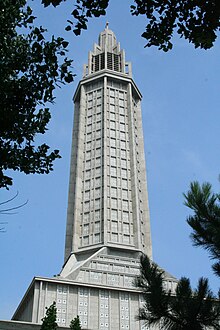You can help expand this article with text translated from the corresponding article in French. (December 2021) Click [show] for important translation instructions.
|
| St. Joseph's Church, Le Havre | |
|---|---|
 | |
 | |
| 49°29′27.5″N 0°6′4″E / 49.490972°N 0.10111°E | |
| Denomination | Roman Catholic |
| History | |
| Dedication | Saint Joseph |
| Architecture | |
| Architectural type | church |
| Administration | |
| Diocese | Le Havre |
| Parish | Saint Martin du Littoral |
| Official name | Le Havre |
| Type | Cultural |
| Criteria | ii, iv |
| Designated | 2005 |
| Reference no. | 1181 |
| Region | Europe and North America |
St. Joseph's Church, Le Havre is a Roman Catholic church in Le Havre, France. From 1945 to 1964, the City of Le Havre commissioned Auguste Perret and his studio to head the rebuilding of the entire city after it had been completely destroyed by the British during World War II.[1] St. Joseph's was built between 1951 and 1957/58 as part of this reconstruction. It acts as a memorial to the five thousand civilians fallen and the usual sanctuary dedicated to a patron saint; in this case Saint Joseph, fittingly the patron saint of a happy death, fathers, workers, travelers, and immigrants.[2]
The church was designed by the chief architect for the reconstruction of Le Havre, Perret, who was the teacher and mentor to the Swiss architect Le Corbusier. A centrally-planned building, Saint Joseph's Church was envisioned as a beacon for the city. The church's single, central tower dominates the city skyline, easily visible from the city's port. Perret's vision created a building resembling a lantern, now fondly referred to as the "lantern tower" or the "lighthouse at the heart of the city". Made of concrete, St Joseph's is a product of modern architectural innovation in Post-War France. The tower is 107 meters tall and acts as a beacon visible from out at sea, especially at night when illuminated.
